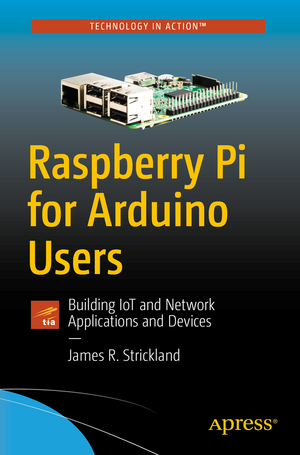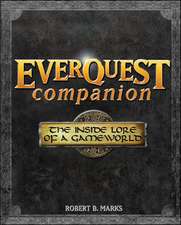Raspberry Pi for Arduino Users: Building IoT and Network Applications and Devices
Autor James R. Stricklanden Limba Engleză Paperback – 20 iun 2018
Leverage your Arduino skills in the Raspberry Pi world and see how to cross the two platforms into sophisticated programs.
The Arduino and Raspberry Pi communities overlap more than you might think. Arduinos can be expanded to have network capabilities with a variety of “shields,” all of which increase the cost and complexity of the system. By contrast, Raspberry Pis all run Linux, which is a very network-competent platform. The newest Pi, the Raspberry Pi Zero W, is WiFi and Bluetooth capable, and costs around $10 U.S. For network enabled gadgets, it makes far more sense to cross to the Raspberry PI platform, if only someone would make it easy to do. That's what this book is about.
You'll learn some survival level Linux system administration, so you know how to set the machine up and how to establish at least minimal security for your gadget. You''ll set up and learn the Geany IDE on your Pi, which is fairly similar to the Arduino IDE.
Where the two platforms overlap the most is the GPIO system. You'll see that several projects use and explain the WiringPi system. This is is deliberately similar to the Arduino's 'Wiring' functionality, which is how sketches interact with GPIO pins. You'll learn the differences between the GPIO pins of the two devices, and how the Pi has some limitations on those pins that the Arduino does not. As a final project, in an effort to escape some of those limitations, you'll attach an AtMEGA 328P to the Raspberry Pi and configure it as a real, 8MHz Arduino with the Arduino IDE running on the Pi, and learn how to have the two platforms communicate, giving you the best of both worlds.
What You'll Learn
- Establish security with Linux system administration
- Set up the Apache webserver
- Write CGI programs so other computers can connect to your Pi and pull datain from it.
- Use C/C++ from Arduino sketches to write programs for the Pi
Who This Book Is For
The Arduino user who's been through all the tutorials and is comfortable writing sketches and connecting hardware to their Arduino.
Preț: 266.88 lei
Preț vechi: 333.60 lei
-20% Nou
Puncte Express: 400
Preț estimativ în valută:
51.07€ • 53.32$ • 42.26£
51.07€ • 53.32$ • 42.26£
Carte disponibilă
Livrare economică 15-29 martie
Preluare comenzi: 021 569.72.76
Specificații
ISBN-13: 9781484234136
ISBN-10: 1484234138
Pagini: 300
Ilustrații: XXVII, 427 p. 62 illus.
Dimensiuni: 155 x 235 x 30 mm
Greutate: 0.64 kg
Ediția:1st ed.
Editura: Apress
Colecția Apress
Locul publicării:Berkeley, CA, United States
ISBN-10: 1484234138
Pagini: 300
Ilustrații: XXVII, 427 p. 62 illus.
Dimensiuni: 155 x 235 x 30 mm
Greutate: 0.64 kg
Ediția:1st ed.
Editura: Apress
Colecția Apress
Locul publicării:Berkeley, CA, United States
Cuprins
Chapter 1: Your Shopping List.- Chapter 2: Meet the Raspberry Pi.- Chapter 3: Survival Linux.- Chapter 4: Meet C++.- Chapter 5: Meet WiringPi.- Chapter 6: Input and Output.- Chapter 7: One Pi, Multiple Processes.- Chapter 8: One Processe, Multiple Threads.- Chapter 9: From Pi to the World: Network Sockets.- Chapter 10: Serving Pi: Network Servers.- Chapter 11: Files and Filesystems.- Chapter 12: The Best of Both Worlds.- Chapter 13: Conclusions, Credits, and Closing Thoughts.
Notă biografică
Jim Strickland has spent his undergraduate, graduate, and professional careers in technical support and system administration—explaining computers and IT systems to others. He's used Unix-like OSs in various incarnations from Ultrix32 in the early 1990s to Slackware Linux in the mid '90s to OS X, Raspbian, and Xubuntu today. And he has experience with non-Unix-like OSes such as MS-DOS, Windows, Macintosh System 7, CP/M-80, and so on. He bought his first Arduino in 2010. Soldering that little board together offered him a crash course in digital electronics making beyond the "Insert board, load driver" level.
He has a master's degree in Communications Development, a BA in creative writing with minors in Computer Science and Psychology. He worked in the computer industry for several years before turning to a writing career. He is the author of Junk Box Arduino: Ten Adventures in Upcycled Electronics and has also written science fiction.
Textul de pe ultima copertă
Leverage your Arduino skills in the Raspberry Pi world and see how to cross the two platforms into sophisticated programs.
The Arduino and Raspberry Pi communities overlap more than you might think. Arduinos can be expanded to have network capabilities with a variety of “shields,” all of which increase the cost and complexity of the system. By contrast, Raspberry Pis all run Linux, which is a very network-competent platform. The newest Pi, the Raspberry Pi Zero W, is WiFi and Bluetooth capable. It makes far more sense to cross to the Raspberry PI platform; this book shows you how to do so.
You'll learn some survival level Linux system administration, so you know how to set the machine up and how to establish at least minimal security for your gadget. You''ll set up and learn the Geany IDE on your Pi, which is fairly similar to the Arduino IDE.
You'll see that several projects use and explain the WiringPi system. This is deliberately similar to the Arduino's 'Wiring' functionality, which is how sketches interact with GPIO pins. You'll learn the differences between the GPIO pins of the two devices, and how the Pi has some limitations on those pins that the Arduino does not. As a final project, in an effort to escape some of those limitations, you'll attach an AtMEGA 328P to the Raspberry Pi and configure it as a real, 8MHz Arduino with the Arduino IDE running on the Pi, and learn how to have the two platforms communicate, giving you the best of both worlds.
Caracteristici
Leverage your Arduino skills to go further with the Raspberry Pi Understand the Raspberry Pi from an Arduino view without starting from scratch Jump to Raspberry Pi for internet of things applications beyond the Arduino


















